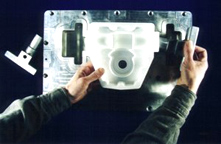
Quick-Cut aluminum prototype tooling provides superior dimensional accuracy, material durability and overall tool life
without compromising a proto-typing
project schedule. |
Prototype Tooling
Prototype tooling can make foam patterns available to the casting customer more rapidly than production tooling and at a fraction of the cost. Prototype tooling can also be used to test process development and information gained is transferable to the production tooling process.
There are several processes for manufacturing prototype tooling including Quick-Cut machined aluminum tooling, cast epoxy tooling, CNC machined epoxy tooling, CNC machined sintered metal tooling and other methods.
Our preferred method of developing prototype tooling is to use a complete three-dimensional model of the part to manufacture Quick-Cut machined aluminum tooling.
The Quick-Cut machined aluminum tooling method provides several advantages over other prototype tooling methods including superior dimensional accuracy, material durability and overall tool life. In addition, portions of the tooling including mold cavities and pulls can be adapted into the production tooling to reduce future tooling costs.
Using prototype tooling methods to produce foam patterns in a standard foundry molding and casting environment will result in patterns with an average higher cost than that of patterns made with production tooling. The average piece price, however, will be lower than Fabricated Foam patterns. The total cost of sample patterns should be calculated as the cost of the tooling plus the cost of setup and molding. For this reason, the best prototype application is when short pre-production runs of twenty to a few hundred pieces are required.
|

